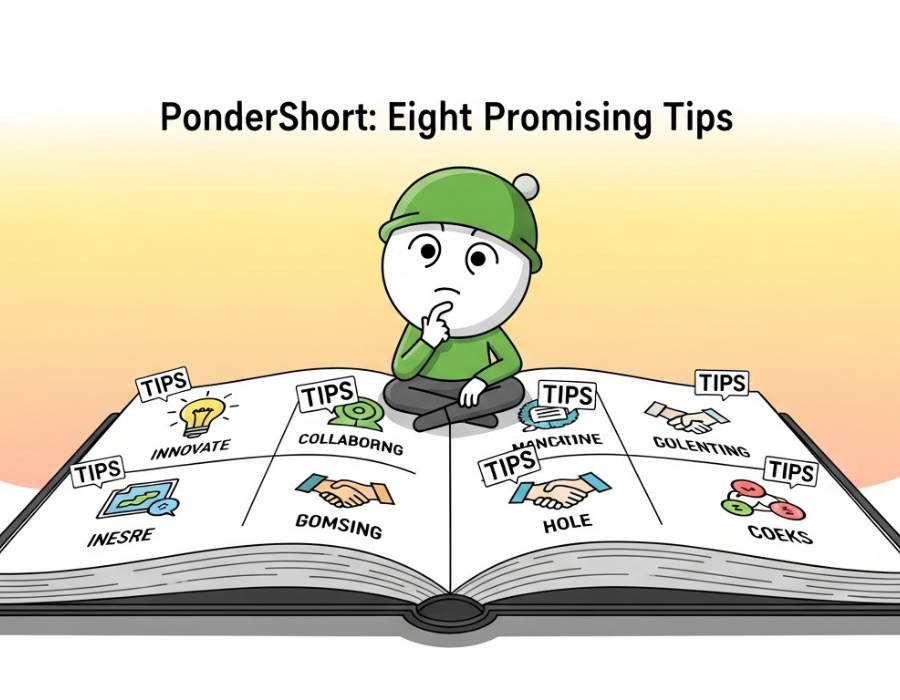In today’s world of endless notifications, quick decisions, and constant distractions, staying focused feels like chasing a butterfly in a storm. That’s where the idea of Pondershort Eight Promising Tips comes in—a set of practical, easy-to-follow principles designed to help you think smart, act efficiently, and live with clarity. These tips aren’t just about productivity; they’re about creating a mindset that balances thought and action, reflection and execution, calm and movement.
Let’s explore each of these eight promising tips in depth so you can start building a life filled with focus, purpose, and momentum.
What Does “Pondershort” Really Mean?
The word “Pondershort” blends two powerful ideas: to ponder—meaning to think deeply—and short—meaning to keep it brief and focused. Together, it suggests a life philosophy: think smartly, act swiftly. It’s about spending just enough time reflecting before taking meaningful action. Imagine holding a compass instead of a map—it doesn’t show every detail, but it points you in the right direction. That’s what Pondershort thinking does for your daily life.
The Philosophy Behind Pondershort Thinking
Pondershort isn’t just another self-help trend—it’s a mindset shift. It encourages clarity, minimalism, and intention. The philosophy is rooted in simplicity: spend less time overthinking and more time doing what truly matters.
When you adopt this approach, you stop chasing perfection and start embracing progress. You’ll find yourself completing tasks faster, feeling less overwhelmed, and focusing more on what brings real value.
Tip #1 – Prioritize What Truly Matters
Most of us fall into the trap of doing everything and end up achieving nothing significant. The first step in Pondershort thinking is prioritization. It’s not about doing more—it’s about doing what matters most.
Start each day by asking yourself: “If I could only complete three things today, what would make the biggest impact?” Once you identify those priorities, channel your energy toward them. Tools like the Eisenhower Matrix or a simple to-do list can help you focus on high-impact activities.
Remember: Saying yes to everything is the fastest way to lose sight of your goals.
Tip #2 – Build a Daily Routine That Inspires Action
Ever noticed how successful people often follow routines? It’s not because they’re boring—it’s because consistency builds momentum. A solid daily routine keeps your day structured, reduces decision fatigue, and helps you stay disciplined.
Design your routine around your energy levels. For example, if you’re more alert in the morning, tackle demanding tasks early. Reserve evenings for reflection or creative thinking.
Think of your daily routine as the “engine” that powers your productivity train. Without fuel (habits), it doesn’t move.
Tip #3 – Stay Curious and Keep Learning
Curiosity is the heartbeat of progress. Whether you’re a student, professional, or homemaker, staying curious keeps your mind active and your ideas fresh.
Ask questions. Explore topics outside your field. Read, listen to podcasts, or take short courses online. The more curious you are, the more innovative you become. Curiosity doesn’t just expand knowledge—it also sharpens problem-solving and creativity.
One way to stay curious is by practicing the “child’s mind” approach—seeing the world as if you’re discovering it for the first time. Every question opens a new door.
Tip #4 – Embrace Simplicity and Declutter Your Mind
In a world obsessed with “more,” true power lies in less. The fourth Pondershort tip is about embracing simplicity. Just as you might tidy your room to create space for comfort, decluttering your mind allows ideas and focus to flow freely.
Try journaling, meditation, or simply listing the things that occupy your thoughts. Once written down, decide which ones deserve your energy and which can go. Minimalism isn’t about owning fewer things—it’s about worrying less about what doesn’t matter.
When your mental space is clear, decision-making becomes effortless.
Tip #5 – Collaborate and Share Ideas
No one achieves greatness alone. Collaboration is where creativity multiplies. Whether at work or in personal life, sharing ideas with others opens your mind to new perspectives and solutions.
Teamwork doesn’t mean losing individuality—it means expanding it. When you work with others, you learn, adapt, and grow faster. Make an effort to listen as much as you speak. Be open to feedback—it’s often the mirror reflecting what you can improve.
Think of collaboration like a puzzle: every person holds a unique piece that completes the bigger picture.
Tip #6 – Take Care of Your Body and Mind
Your body is your engine, and your mind is the driver—both must work in harmony. Without self-care, productivity crumbles.
Prioritize sleep, nutrition, and exercise. Even a 20-minute walk or a few stretches during breaks can make a world of difference. Equally important is mental health—practice mindfulness, talk to loved ones, or take short digital detoxes.
When you take care of yourself, you don’t just feel better—you perform better. Self-care isn’t selfish; it’s strategic.
Tip #7 – Track Your Progress and Reflect Regularly
Progress isn’t about moving fast—it’s about moving forward intentionally. Tracking your efforts helps you see how far you’ve come and what needs adjustment.
You can use a journal, app, or even sticky notes on your wall. Each small win builds motivation. Reflection at the end of the week helps you learn from mistakes and celebrate victories.
Ask yourself: “What worked well this week? What will I do differently next time?” Reflection turns experience into wisdom.
Tip #8 – Stay Consistent and Maintain Momentum
Consistency is the bridge between goals and success. It’s easy to start strong, but staying the course is where most people stumble. The final Pondershort tip reminds you to keep moving, even when motivation fades.
On tough days, focus on doing something small. A single step forward is still progress. Momentum builds through repetition—each action reinforces the next.
Imagine pushing a heavy cart uphill—the first few pushes are hardest, but once it starts rolling, momentum takes over. That’s consistency in action.

How Pondershort Thinking Boosts Productivity
Combining all eight tips creates a synergy that transforms how you think, work, and live. You become more intentional with your time, more confident in decisions, and less burdened by clutter or overthinking.
Pondershort thinking helps you:
-
Stay focused on meaningful goals
-
Avoid burnout through mindful habits
-
Build sustainable success instead of short bursts of effort
It’s not about working harder—it’s about working smarter and living with clarity.
Mastering the Art of Pondershort Living
Mastering Pondershort thinking is like tuning a musical instrument—you have to adjust regularly to stay in harmony. The goal isn’t perfection; it’s progress.
By practicing these eight promising tips, you train your mind to think efficiently, act purposefully, and grow continuously. Life becomes less about rushing and more about rhythm—finding the perfect balance between pause and play.
So, take a moment today. Breathe. Reflect. Choose one tip and start applying it. That’s the beauty of Pondershort—it turns big change into small, manageable actions that build over time.
Frequently Asked Questions (FAQs)
1. What is the main idea behind Pondershort Eight Promising Tips?
The main idea is to help individuals live smarter and more purposefully by combining thoughtful reflection with focused action. It’s about simplifying your life while maximizing results.
2. How can I apply these tips in my daily routine?
Start small. Pick one tip—like prioritizing key tasks or decluttering your mind—and practice it for a week. Gradual changes are easier to maintain than drastic ones.
3. Are Pondershort tips only for professionals?
Not at all. These principles apply to everyone—students, homemakers, entrepreneurs, or retirees. Anyone seeking focus, balance, and clarity can benefit.
4. How long does it take to see results from these tips?
Results vary, but most people notice improvements in focus and mood within a few weeks of consistent practice. The key is persistence, not speed.
5. Can Pondershort thinking help with stress and anxiety?
Yes. By simplifying your thoughts, managing priorities, and maintaining self-care, Pondershort methods reduce mental clutter—helping you feel calmer and more in control.


